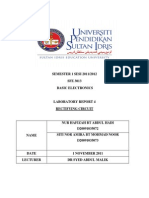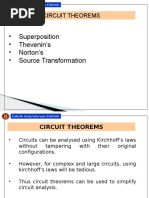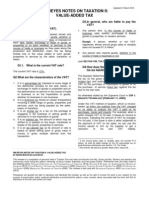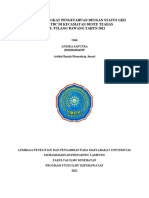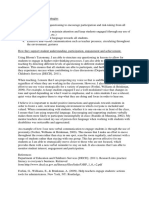Lab Report 8
Uploaded by
Nebil YisuLab Report 8
Uploaded by
Nebil YisuAddis Ababa University
Faculty of Technology
Department of Electrical and Computer Engineering
Laboratory Report
Course number: Eceg: - 2205 - Electrical Engineering Laboratory II
Experiment Number: 08
Title: The Frequency Response of a Transistor Amplifier
9V
4.7µF
120 KΩ
10µF
27 KΩ
3.9 KΩ
56 KΩ
1 KΩ 220µF
es
Figure A: A Circuit Layout Diagram for the laboratory session
By: Besufekad Mekuria
Group: 1B, Subgroup 5, ID: TCR/0590/01
Date of Lab. session: December 30, 2009
Date of submission: January 06, 2009
AAU, FACULTY OF TECHNOLOGY, DEPARTMENT OF ELECTRICAL ENGINEERING, LABORATORY II REPORT 0
TABLE OF CONTENTS:
Section Sub-Title Location
NO
1.1 Introduction Page Two
1.2 Objective Page Two
1.3 Preparation Page Two
1.4 Used Equipment Page Two
1.5 Components used Page Two
1.6 Theory Page Three
1.7 Calculations Page Three
1.8 Procedure Page Four
1.9 Results Page Five
1.10 Conclusion Page Six
AAU, FACULTY OF TECHNOLOGY, DEPARTMENT OF ELECTRICAL ENGINEERING, LABORATORY II REPORT 1
The Frequency Response of a Transistor Amplifier
1.1 INTRODUCTION
We study the response of an amplifier that uses transistors to varying frequencies by
using the hybrid π model for the transistors.
1.2 OBJECTIVE
A. Observing the response of an RC coupled common emitter amplifier with variant input voltage
frequencies.
B. To determine the phase and gain characteristics with carrying frequencies.
C. To know the π properties of the amplifier.
1.3 PRE-LAB PREPARATION
Before the laboratory session, the manual that was supplied by the instructors included detailed
theory about the procedures that would have to be undergone or carried out in order to properly assess
the frequency response characteristics of the Transistor Amplifier circuit while the Transistor is used in
an RC coupled common emitter amplifier.
1.4 USED EQUIPMENT
No Description Type/Code/Lab Reference Quantity
1 Regulated DC Power source 9V 1
2 Electronic or Vacuum Tube VOM - 1
3 Dual Channel Cathode Ray Oscilloscope - 1
4 Conducting Wires - 15
5 Decade Resistor - 1
6 Transistor BC – 101B 1
Table 1: Electrical Equipments that were used to set up the circuit for the laboratory procedure
.
1.5 USED COMPONENTS
No Description Type Quantity
1 Resistors Variant: (120K,86K,1.8K,27K) 1 of every kind
2 Circuit Board - 1
3 Capacitors Variant: (27,10,4.7,220,0.027) µF 1 of every kind
Table 2: Electrical Components that were used to set up the circuit for the laboratory procedure
AAU, FACULTY OF TECHNOLOGY, DEPARTMENT OF ELECTRICAL ENGINEERING, LABORATORY II REPORT 2
1.6 THEORY
Let us first start by defining some important terms:
FT: or Transitional Frequency is the frequency at which the short circuit common emitter current
gain becomes unity.
Therefore, Frequency response of a circuit means variation of the phase, gain and other
parameters caused as a result of changes in frequency. Note that all of this is done while making sure
that the amplitude of the voltage is kept constant at a certain value.
Figure 1: A π Model used for Demonstrating the frequency response of a Transistor
1.7 Calculations
For the networks shown in figure 1 and 2, we can easily determine the output and the input
voltages by applying Kirchhoff’s voltage and current law.
That is:
As Usual, Gain is defined as the ratio of the output voltage to input (Vo/Vi)
Therefore:
1. For a frequency of 10 Khz, with es =20mVpp and e0 = 0.6Vpp
The corresponding Gain will be: Gain = 0.6Vpp/20mVpp = 300
2. For a frequency of 20 Khz, with es =20mVpp and e0 = 0.8Vpp
The corresponding Gain will be: Gain = 0.8Vpp/20mVpp = 400
3. For a frequency of 150 Khz, with es =20mVpp and e0 = 1.2Vpp
AAU, FACULTY OF TECHNOLOGY, DEPARTMENT OF ELECTRICAL ENGINEERING, LABORATORY II REPORT 3
The corresponding Gain will be: Gain = 0.6Vpp/20mVpp = 600
And as it is well known, cut off frequencies take place at specific Gains i.e Gain = Midgain * 0.7069
For instance, for the input amplitude of 20 mVpp the maximum possible Gain can take
place in the range between 500Hz to 50,000 Hz. Midgain = 1.4 Vpp/20mVpp = 700
Gain at cut off frequency = 700 * 0.7069 = 500, therefore cutoff frequencies are:
100Hz and 100,000 Hz.
Concerning the phase shift properties, we utilize a special kind of mode of the CRO called the
x-y (Lissajous image mode).
X
Y
Phase Shift Angle (θ):
Θ = sin -1 (X/Y)
Figure 3: A Lissajous pattern figure can be used to determine the phase difference angle (θ)
between the input signal (es) and out put amplified signal (e0).
1.8 PROCEDURE
All of the according steps and procedures carried out in the class were done accordingly to the
laboratory manual supplied to us by the laboratory instructors.
5.1 The circuit was setup according to circuit figure, and VCC was set to 9V, while checking V CE to be
around 3.5 V. and IC 2mA.
5.2 The signal generator was connected at the input terminal generating a 1Khz, 20 mVpp. And the
value of the output voltage e0 was measured. Again the process was repeated for es = 30 mVpp and
the Amid was calculated.
5.3 Considering the frequency range of 10 Hz to 1 MHz, the Gain vs Frequency graph was plotted by
taking all the necessary measurements, this was done while keeping es constant at 20mVpp.
The gain was determined for each frequency with a capacitor ‘c’ and without it
AAU, FACULTY OF TECHNOLOGY, DEPARTMENT OF ELECTRICAL ENGINEERING, LABORATORY II REPORT 4
5.4 The capacitor ‘c’ was removed from the circuit and both the input and output terminals of the
network were connected to the two channels of the CRO, and then using the phase difference
comparison mode (Lissajous Figure), the phase angle was determined for the same frequency ranges
as was used in procedure 5.3.
9V
4.7µF
120 KΩ
10µF
27 KΩ
3.9 KΩ
56 KΩ
1 KΩ 220µF
es
Figure 1: A Circuit Layout Diagram for the laboratory session
1.9 Results
In this section, the results to the measurements taken during the section will be classified according to
the procedures on the lab manual,
5.3
Input AC Output Amplitude Output Amplitude Gain Phase Shift
Frequency (with no e0) (with e0) Sin -1 (x/y)
10 Hz 0.56 V 0.4 V 300
20 Hz 0.78 V 0.8 V 400
40 Hz 1.16 V 1.2 V 600
100 Hz 1.16 V 1.4 V 700
500 Hz 1.3 V 1.4 V 700
1 KHz 1.3 V 1.4 V 700
50 KHz 1.3 V 0.8 V 700
100 KHz 1.2 V 0.6 V 600
150 KHz 0.29 V 0.4 V 150
250 KHz 0.2 V 0.3 V 100
500 KHz 0.1 V 0.2 V 50
1MHz Approx 0 V Approx 0 V Approx
0
AAU, FACULTY OF TECHNOLOGY, DEPARTMENT OF ELECTRICAL ENGINEERING, LABORATORY II REPORT 5
1.10 Conclusion
To briefly restate the main concepts we grasped upon completion of the laboratory session, we were able
to understand many things, each will be discussed under its own title.
Observations made about the frequency Response of the network
Frequency response of a circuit means variation of the phase, gain and other parameters caused
as a result of changes in frequency. Note that all of this is done while making sure that the amplitude of
the voltage is kept constant at a certain value. FT: or Transitional Frequency is the frequency at which
the short circuit common emitter current gain becomes unity.
And as it can be seen from the results, even though the length of frequency that must be
transpassed is a very long range that a semi-log paper is required to graph the Gain versus Frequency
behaviors of the circuit, it can be said that frequency has an increasing effect on the gain for a certain
range (starting from zero, and in the amplifier that was setup in the lab that range was from zero Hertz
to 100 Hz) , then, the gain stays relatively unaffected by frequency (from 100 Hz to about 50 KHz in the
lab) , after that, increase in frequency has a decreasing effect on the Gain, (from 50 KHz to 1 MHz and so
on to infinity).
Observations made about Structural composition of transistors
The Transistor is composed of three major parts in the semiconductor matrix, these are: The Emitter,
the Base and the Collector. All of the input and output characteristics of the network can be measured
by connecting the appropriate measuring meter as shown by the circuit diagram figure (A).
Although it wasn’t part of the procedure, our instructors have demonstrated to us that a special kind
of Oscilloscope can be used to depict the VCE versus ICE Graph.
Observations made about the Ratings of the Transistor
For the proper functioning of the Transistor, certain values of current and voltage (also inherently,
power) should not be surpassed. These values are called: Current Rating, Voltage Rating and Power
rating respectively. And even though the values weren’t imprinted on the transistor we worked on, the
laboratory manual we used instructed for us not to surpass the following value, so, this value can be
considered as the Current Rating value,: IB = 250µA.
Observations made about the Amplification properties of the Transistor
Transistors can be used to amplify voltages, as observed from the laboratory session, the gain of 40,
implies that the input voltage has been magnified 40 times, and hence the transistor has been used as
an Amplifier.
AAU, FACULTY OF TECHNOLOGY, DEPARTMENT OF ELECTRICAL ENGINEERING, LABORATORY II REPORT 6
Observations made about practical errors
As it is a known fact, there does not exist a circuit element that functions with a hundred percent
efficiency. Therefore slight deviations of the measured values from the calculated ones are to be expected under
any circumstances. However the possible causes for these irregularities include:
The DC voltmeter does not give rise to a potential difference with a magnitude that it is programmed to do.
This is generally due to manufacturing defects, defects from improper usage and gradual wearing off.
The leads are not of Zero Resistance; this is because of factors like: Temperature change, corrosion due to
exposure to Atmospheric Humidity, etc…
The Ammeter used was an analog device; therefore readings are perceptible to be misconstrued. And also
continuous mistreatment of the device leads to incorrect readings in the future.
End of Report
AAU, FACULTY OF TECHNOLOGY, DEPARTMENT OF ELECTRICAL ENGINEERING, LABORATORY II REPORT 7
You might also like
- Unit 2 Transmission lines and Waveguides 23_24.ppt100% (1)Unit 2 Transmission lines and Waveguides 23_24.ppt130 pages
- BM8076 Electrical Safety and Quality Assurance100% (1)BM8076 Electrical Safety and Quality Assurance1 page
- Investigation of Transistor Characteristics of N-P-N and P-N-PNo ratings yetInvestigation of Transistor Characteristics of N-P-N and P-N-P9 pages
- Interpretation of Data and Result and Conclusion. Exp.6 - Resonance FrequencyNo ratings yetInterpretation of Data and Result and Conclusion. Exp.6 - Resonance Frequency1 page
- ENA Lab 9 Balanced Three-Phase Circuit (Software)No ratings yetENA Lab 9 Balanced Three-Phase Circuit (Software)12 pages
- Lab 4: Introduction To Operational Amplifiers: ObjectiveNo ratings yetLab 4: Introduction To Operational Amplifiers: Objective10 pages
- Unit-II Bio Signal Characteristics and Electrode ConfigurationsNo ratings yetUnit-II Bio Signal Characteristics and Electrode Configurations54 pages
- Lab Report 11 The Oscilloscope Part 1 FaNo ratings yetLab Report 11 The Oscilloscope Part 1 Fa7 pages
- Experiment No: 1 Title: Objective: Design and Realize Inverting and Non-Inverting Amplifier Using 741 Op-Amp. TheoryNo ratings yetExperiment No: 1 Title: Objective: Design and Realize Inverting and Non-Inverting Amplifier Using 741 Op-Amp. Theory2 pages
- A TV Camera Tube May Be Called The Eye of A TV SystemNo ratings yetA TV Camera Tube May Be Called The Eye of A TV System8 pages
- LAB 1: Per Unit System in Transmission and DistributionNo ratings yetLAB 1: Per Unit System in Transmission and Distribution13 pages
- 1) Smart Farming System: 2) Home Automation System Using Raspberry Pi and Temparature & Humidity SensorNo ratings yet1) Smart Farming System: 2) Home Automation System Using Raspberry Pi and Temparature & Humidity Sensor5 pages
- Triangular Wave Generator Using Op Amp - EEEGUIDE PDF100% (1)Triangular Wave Generator Using Op Amp - EEEGUIDE PDF6 pages
- Experiment # 5 To Examine The Diode Applications As: Diode Clippers/LimitersNo ratings yetExperiment # 5 To Examine The Diode Applications As: Diode Clippers/Limiters3 pages
- The Present Perfect Tense and Past PerfectNo ratings yetThe Present Perfect Tense and Past Perfect5 pages
- BOPPPS Session Plan - Respect For DiversityNo ratings yetBOPPPS Session Plan - Respect For Diversity2 pages
- Promotional Strategies & Print Ad For Cold Creams100% (1)Promotional Strategies & Print Ad For Cold Creams12 pages
- 01- 24 MLD STP Bijnor Power Consume Report January-2025No ratings yet01- 24 MLD STP Bijnor Power Consume Report January-20251 page
- Tirumala Cotton Recruitment and Selection Recruitment and Selection RCENo ratings yetTirumala Cotton Recruitment and Selection Recruitment and Selection RCE71 pages
- PM Reyes Notes On Taxation 2 - Valued Added Tax (Working Draft)100% (1)PM Reyes Notes On Taxation 2 - Valued Added Tax (Working Draft)22 pages
- Marine Pollution Assignment 2 Inc. Front SheetNo ratings yetMarine Pollution Assignment 2 Inc. Front Sheet2 pages
- Sensors: Evolution of RFID Applications in Construction: A Literature ReviewNo ratings yetSensors: Evolution of RFID Applications in Construction: A Literature Review21 pages
- Climate Protection and Environmental Interests in Renewable Energy Law: Perspectives From Brazil and Germany Paula Galbiatti Silveira100% (2)Climate Protection and Environmental Interests in Renewable Energy Law: Perspectives From Brazil and Germany Paula Galbiatti Silveira49 pages
- How A COE (Center of Excellence) Drives Efficiency Across Your Organization - LinkedInNo ratings yetHow A COE (Center of Excellence) Drives Efficiency Across Your Organization - LinkedIn5 pages
- Performance Review Toolkit - Tools, Tips, Templates, and MoreNo ratings yetPerformance Review Toolkit - Tools, Tips, Templates, and More41 pages
- 2024 02 6 10 51 09 Statement - 1717305669606No ratings yet2024 02 6 10 51 09 Statement - 171730566960625 pages
- KDS 14 20 64 Design Standard For Structural Plain ConcreteNo ratings yetKDS 14 20 64 Design Standard For Structural Plain Concrete11 pages
- Unit 2 Transmission lines and Waveguides 23_24.pptUnit 2 Transmission lines and Waveguides 23_24.ppt
- Investigation of Transistor Characteristics of N-P-N and P-N-PInvestigation of Transistor Characteristics of N-P-N and P-N-P
- Interpretation of Data and Result and Conclusion. Exp.6 - Resonance FrequencyInterpretation of Data and Result and Conclusion. Exp.6 - Resonance Frequency
- Lab 4: Introduction To Operational Amplifiers: ObjectiveLab 4: Introduction To Operational Amplifiers: Objective
- Unit-II Bio Signal Characteristics and Electrode ConfigurationsUnit-II Bio Signal Characteristics and Electrode Configurations
- Experiment No: 1 Title: Objective: Design and Realize Inverting and Non-Inverting Amplifier Using 741 Op-Amp. TheoryExperiment No: 1 Title: Objective: Design and Realize Inverting and Non-Inverting Amplifier Using 741 Op-Amp. Theory
- A TV Camera Tube May Be Called The Eye of A TV SystemA TV Camera Tube May Be Called The Eye of A TV System
- LAB 1: Per Unit System in Transmission and DistributionLAB 1: Per Unit System in Transmission and Distribution
- 1) Smart Farming System: 2) Home Automation System Using Raspberry Pi and Temparature & Humidity Sensor1) Smart Farming System: 2) Home Automation System Using Raspberry Pi and Temparature & Humidity Sensor
- Triangular Wave Generator Using Op Amp - EEEGUIDE PDFTriangular Wave Generator Using Op Amp - EEEGUIDE PDF
- Experiment # 5 To Examine The Diode Applications As: Diode Clippers/LimitersExperiment # 5 To Examine The Diode Applications As: Diode Clippers/Limiters
- 01- 24 MLD STP Bijnor Power Consume Report January-202501- 24 MLD STP Bijnor Power Consume Report January-2025
- Tirumala Cotton Recruitment and Selection Recruitment and Selection RCETirumala Cotton Recruitment and Selection Recruitment and Selection RCE
- PM Reyes Notes On Taxation 2 - Valued Added Tax (Working Draft)PM Reyes Notes On Taxation 2 - Valued Added Tax (Working Draft)
- Sensors: Evolution of RFID Applications in Construction: A Literature ReviewSensors: Evolution of RFID Applications in Construction: A Literature Review
- Climate Protection and Environmental Interests in Renewable Energy Law: Perspectives From Brazil and Germany Paula Galbiatti SilveiraClimate Protection and Environmental Interests in Renewable Energy Law: Perspectives From Brazil and Germany Paula Galbiatti Silveira
- How A COE (Center of Excellence) Drives Efficiency Across Your Organization - LinkedInHow A COE (Center of Excellence) Drives Efficiency Across Your Organization - LinkedIn
- Performance Review Toolkit - Tools, Tips, Templates, and MorePerformance Review Toolkit - Tools, Tips, Templates, and More
- KDS 14 20 64 Design Standard For Structural Plain ConcreteKDS 14 20 64 Design Standard For Structural Plain Concrete




